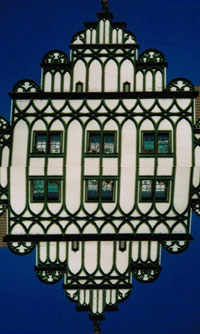
Navigation Sketch for the Seminary:
Unit I: To generate plausibilty – now!
In this unit, the possibilities of project orientated art work are to be probed, the heterogeneous elements of which often widely distributed in space and time connect on different levels. Practical examples will show how this connecting process can be achieved. In this context, the term 'plausibilty' will be used as a kind of quality mark to evaluate the success of such projects. How are elements to be aligned in order to generate plausibility?
- context of meaning
- actions and events
- situational references
- the repetitive model: distribution and repetition
- medial anchoring
- participial endeavour
- inter-contextual connections
Unit II: Is Weimar real, or is it not?
In this unit definitions with regard to the term 'Public Space' are to be achieved, looking beyond the received one of regarding it as merely the empty space between buildings. Demonstrably, the complexity of Public Space is based, not solely on the simultaneity of casualisms, but also on the simultaneity of perceptions, which, as dissimilar specific points of view, contribute to the
construction of reality.
- to which extent is reality being medially constructed
- Public Space as a space of collective consciousness
- Public Space as a space of signs
- Public Space as a space of events
- different rights of access to Public Space
- publication of privacy (Big Brother, talk shows)
- historical concepts of Public Space (the forum in antiquity;Haussmann's Paris city design;
Le Corbusier's 'Plan Voisin', etc.)
Proposed paper subjects:
This proposition is aimed especially at the foreign students (Autralia, Italy, Thailand, to the best of my knowledge), because it is desirable for them to contribute their own experience of cultural differences. The idea is for them to present, in concise talks, the differences in use, perception and character of Public Space in their own country as compared to Germany, either with regard to a specific example, or a rather more general evaluation. Roland Barthe's book 'L'empire de signes' may be used as exemplary background material.
Unit III: Only if that which is, is not the whole …
This unit will examine specific difficulties arising from the connection of those art work strategies discussed in unit I, and the external conditions as defined in unit II, i.e. difficulties created through the practical appliance, by the artist, of these strategies within Public Space. These may be caused by misunderstandings as well as real conflicts of interests. Conflict potential will be pointed out by means of practical examples. The aim here is not merely the development of
avoidance strategies, but it will also be discussed in which way such potentials may be used deliberately to enhance the dynamics of the art process.
- different purposes (representation, advertising, entertainment, revaluation of residential quarters, etc.)
- self-deceptive rationalisations
- competing offers
- misjudgements
- the role of the media
- provocation, escalation and de-escalation
- re-channelling resistance into energised velocity


